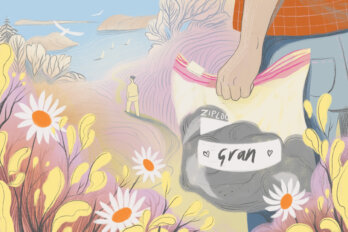Last September, at the Invictus Games in Toronto, Meghan Markle signaled to the world that she would one day marry Prince Harry of Wales, and that she would do so in her own way. It was the first time the now newly minted Duchess of Sussex first was spied publicly with her then boyfriend. The couple made no public statement, but then again, they didn’t have to: clothes did the talking. Markle’s “husband shirt”—as its designer, Misha Nonoo, christened the white men’s-style dress shirt that her friend was flaunting that day—made the point loud and clear: this love match was made for the altar. And though nobody could yet imagine that Markle’s father, Thomas Markle, would one day talk to TMZ on his daughter’s big day or that Bishop Michael Curry would command the pulpit at St George’s Chapel, the rest of her outfit also carried a message.
On that momentous day in the GTA, Markle’s distressed denim—made by Mother, a brand that champions “unconditional love” and “teenage rebellion”—was a sure sign that the inevitable royal nuptials were likely to be, well, modern. Perhaps even cool.
In one sense, the international attention paid to Markle’s every sartorial choice since her first outing as Prince Harry’s partner is nothing new. The public has long obsessed over the fashion choices of both royals (Diana, Kate) and influential political wives (Sophie, Michelle, Jackie). But something about Markle, who is now officially the Duchess of Sussex, as an icon in the making, feels different. She has the potential for a broader influence—not least because we so rarely see her stumble.
A TV celebrity before her second marriage, to Prince Harry, Markle’s media experience distinguishes her from both former first ladies and House of Windsor princesses and could significantly enhance the power she exerts within fashion. Unlike her forerunners (or most ordinary women), she is not coming at the job of making appearances and of choosing what to wear in public as a neophyte. Long before she met her prince, she had her camera-ready look in place.
Markle spent her childhood in the spotlight, by the side of her father, a lighting director—as a Canadian TV star told me on the day of Markle’s royal wedding, “Lighting is everything.” Her mother, Doria Ragland, is a yoga instructor and social worker. Attending Immaculate Heart High School in Los Angeles, Markle spent years in a school uniform. (The casual polish she currently exudes—not to mention the pretty bounce of her lustrous locks, as well as the jaunty hats she’s known to brandish—definitely owes something to the relaxed refinement of another Immaculate Heart graduate, Mary Tyler Moore.) From there, Markle went on to earn a bachelor’s degree from Northwestern University, with a double major in theatre and international studies, and later befriended stylist Jessica Mulroney (daughter-in-law to the eternally chic Mila Mulroney and fashion adviser to the current prime minister’s wife, Sophie Grégoire Trudeau).
And, of course, there’s the fact that she starred for seven years as Rachel Zane on the USA Network TV show Suits. Working on the show let Markle collaborate with expert costume designers. Part of a costumer’s job is to teach their acting charges how to look fabulous from every possible camera angle. That the duchess has excelled is currently evidenced all over the internet. By contrast, the sartorial disappointments during the engagement periods of Diana, who would go on, in her life, to be known as the Princess of Wales, and Sarah, the to-be Duchess of York, were myriad. More recently, it wasn’t until two months after her wedding day that Catherine, Duchess of Cambridge, finally found her fashion identity—think polished woman next door—in a wardrobe by Erdem, Roksanda, Alexander McQueen, Catherine Walker, and Jenny Packham. Meanwhile, Markle was trooping around confidently in Manolos as soon as she washed up on British shores.
From here on in, for better or worse, the Duchess of Sussex’s every style choice will be scrutinized by critics who will highlight any snafus as proof that this foreigner was not fit to marry Prince Harry, a national treasure. The Duchess of Sussex is now an integral member of “the Firm”—as her grandfather-in-law, the Duke of Edinburgh, has famously referred to his extended family. And there was no surer sign that she is now determined to fit in than her choice of footwear at Prince Charles’s seventieth birthday celebrations at Buckingham Palace, which was her first public outing since her wedding. First, her “nude” shoes. These were the sort of neutral-hued patent pumps favoured with formal attire by the House of Windsor’s female members. As for her legs, despite Markle’s recent nods to modern style, fashionably bare limbs are not accepted within the British royal family; that day, she wore hose. What’s more, exposed body parts signify immodesty, and as the duchess had already discovered after flaunting her shapely arms at a church memorial service prior to her nuptials, they are a big no-no; that day, she also opted for sleeves.
Even with all her prior training and polish, the married Markle really has yet to define her look—perhaps because of the tautological demand of her position as the partner of a beloved public figure to evoke both style and substance, as she gets on with it all. Exuding both is a feat aspired to by so many wives of important diplomatic figures since Jacqueline Kennedy Onassis projected this particular mix of qualities during her husband John F. Kennedy’s two-year term as US president. “Dear Mrs. Kennedy,” an episode of The Crown, which aired last year, portrays Jackie Kennedy forging the way for the US during a 1961 state visit to Paris. Her appearance in a Hubert de Givenchy gown at a Versailles Palace banquet supposedly so charmed President Charles de Gaulle that it’s been said she also helped ease diplomatic negotiations between the French leader and JFK. Whether that’s true (her fluency in French likely helped as well), done well, a woman’s “look” can communicate the layers of who she is to the world. It can portray the substance of who her partner is, her own views, even the role of her nation and her role within it.
Royals also traditionally forge a bond with their designers, and who they choose matters far beyond the actual “look” (not, it might be noted, a responsibility shared by men). The Duchess of Cambridge’s promotion of Alexander McQueen since her wedding to Prince William can been seen as a nationalistic (if stylish) symbol. The selection of Clare Waight Keller, designer of Markle’s wedding dress—a woman newly in charge in the realm of Paris couture, which, for over a century, has been dominated by men—was likely an appealing choice for the Duchess of Sussex, who on the royal family’s website is identified as a feminist and a champion of gender equality.
The high-neck, silk crepe Stella McCartney showstopper that Markle donned for her festive Frogmore House evening wedding reception also seemed to communicate some of Markle’s values—and was an intriguing choice given that Stella McCartney is half American, half British, just like the House of Windsor union. The ethical ethos which guides McCartney—a lifelong vegetarian who doesn’t work with leather and favours sustainable methods—also jives with the fashion philosophy of the duchess. From time to time, Markle dresses “head-to-toe eco.” But, above all, the Stella McCartney reception dress seemed to be another girl-power move. In March, Kering, the luxury corporation that previously backed 50 percent of Stella McCartney brand, announced that the designer would own it entirely herself. The royal seal of approval, in addition to the outfitting of Hollywood royalty, including wedding guests Amal Clooney and Oprah Winfrey, acts as an important boost for McCartney’s forward course of independence.
So perhaps the biggest question is: Where will the duchess go from here in terms of fashion? A long line of first ladies, presidential and prime minister’s wives, and royal consorts have followed in Kennedy’s wake, and yet are arguably remembered, style-wise, for nothing more than their inauguration gown, haircut, a signature accessory, or a financial scandal related to the exorbitant cost of their wardrobe (think Mila Mulroney and Nancy Reagan). This demonstrates that channeling one’s persona through a strategically assembled wardrobe is something of a fine art, requiring both vision and purpose. Done well, fashion can communicate a world view—particularly within the confines of being a famous wife and especially one under immense public pressure to essentially stop being a human being and instead become a form of socially licensed Stepford wife.
During her eight years in the White House while her husband, Barack Obama, served as a two-term United States president, Michelle Obama managed to communicate both poise and vision. Putting her career—and opinions—on hold, Obama’s championing of fashion became a firm part of her role as first lady of the United States. Though Michelle Obama’s approach was very Hollywood—i.e., like every major celebrity today, she employed a stylist to help choose her clothes—sound business was also at the core of her mission. She commenced work as first lady during the 2008 financial crisis and her work peaked at a time when fashion had discovered social media as a marketing tool. For every major fashion label in which she appeared on Instagram or Facebook, Obama also appeared in as many designs produced by struggling brands, startups, and those fronted by visible minorities. Besides developing her own image, Obama was also supporting jobs and the economy.
Sophie Grégoire Trudeau and Brigitte Macron have followed Obama’s lead. While Prime Minister Justin Trudeau’s wife appears to use her position to promote a host of Canadian fashion brands, President Macron’s marital partner dresses almost exclusively in Louis Vuitton, therefore supporting the modernity the label’s artistic director, Nicolas Ghesquière, has lent to the age-old French luxury brand. Now it is the Duchess of Sussex’s turn to project her image on the world stage.
Markle is the first biracial member of the British royal family, and, as a duchess, she occupies a position of great power. While her grandmother-in-law is Britain’s head of state, this newly minted royal highness, like all House of Windsor members, has no political or executive role in the nation. However, hundreds of millions watched her wedding. It was one of this year’s most monitored events, and if viewership and media attention are anything to go by, the dynamic effervescence she and her husband radiate—not just in person but all manners of merchandise and marketing, including the double-decker royal tour buses upon which their faces are splashed—should significantly boost the £550 million in British tourism revenue which was generated in 2017 by the royals. As duchess, Meghan is gold dust right now to any designer. Let’s hope she will conjure sartorial magic—and a point of view—as she eases into her new life at Kensington Palace.





